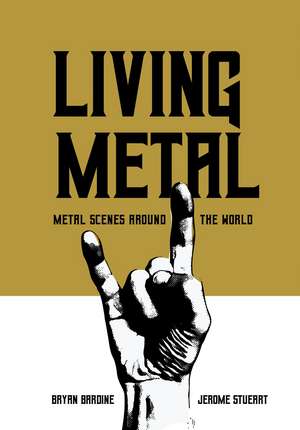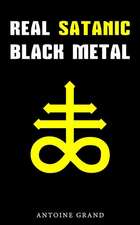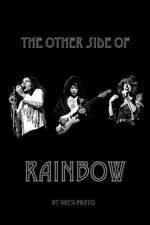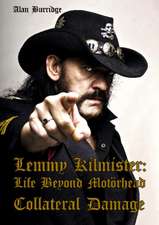Living Metal: Metal Scenes around the World: Advances in Metal Music and Culture
Editat de Bryan Bardine, Jerome Stueart Cuvânt înainte de Henkka Seppäläen Limba Engleză Paperback – 22 iun 2023
This edited volume expands the research in the field of metal studies by examining metal music communities around the world, from Dayton, Ohio, to Estonia to post-apartheid South Africa and beyond. The chapters are detailed, richly embedded in local histories and contexts, and provide important analyses of their respective scenes. The diversity of the chapters connects metal to other disciplines in the music field and a foreword by Henkka Seppälä, former bassist of the Finnish extreme metal band Children of Bodom, accompanies the essays. Living Metal is a groundbreaking contribution to the field, with much appeal for fans and scholars of metal music as well as those in the fields of anthropology, musicology, and history.
Preț: 207.49 lei
Nou
Puncte Express: 311
Preț estimativ în valută:
39.71€ • 43.12$ • 33.35£
39.71€ • 43.12$ • 33.35£
Carte disponibilă
Livrare economică 01-15 aprilie
Livrare express 15-21 martie pentru 31.91 lei
Preluare comenzi: 021 569.72.76
Specificații
ISBN-13: 9781789387582
ISBN-10: 1789387582
Pagini: 312
Ilustrații: 36 color plates
Dimensiuni: 170 x 244 x 20 mm
Greutate: 0.5 kg
Editura: Intellect Ltd
Colecția Intellect Ltd
Seria Advances in Metal Music and Culture
ISBN-10: 1789387582
Pagini: 312
Ilustrații: 36 color plates
Dimensiuni: 170 x 244 x 20 mm
Greutate: 0.5 kg
Editura: Intellect Ltd
Colecția Intellect Ltd
Seria Advances in Metal Music and Culture
Notă biografică
Bryan Bardine is professor of English at the University of Dayton in Ohio. He is the coeditor of Connecting Metal to Culture: Unity in Disparity, also published by Intellect. Jerome Stueart is a freelance writer, editor, and artist living in Columbus, Ohio. He teaches classes in science fiction and fantasy writing.
Cuprins
Acknowledgements
List of Figures
Foreword
Henkka Seppala, M.A.
Introduction
Dr. Bryan A. Bardine and Dr. Jerome Stueart,
Chapter 1: From The Ashes of the Fallen Empire: Heavy Metal and Community in
Post-Apartheid South Africa
Edward Banchs, MA
Chapter 2: Polar Fate: Mapping Metal at the Southern Edge of the World
Dr. Catherine Hoad
Chapter 3: The Enemy Within: Conceptualizing Turkish Metalheads as the Ideological
‘Other’
Dr. Pierre Hecter and Douglas Mattsson, M.A.
Chapter 4: ‘Métal noir épique patriotique’: Analysis of historical, sociological and cultural discourses uniting metal noir québécois and Québec society.
Mei-Ra St. Laurent, PhD
Chapter 5: Living Sonic Knowledge in South-Eastern Austria: The Sound History of the Metal Scene in Graz and Styria, c. 1980 to the Present
Dr. Peter Pichler
Chapter 6: Heavy Metal Scene in Osaka: Localness Now and Then
Dr. Kei Saito
Chapter 7: Heart of Sadness: Fieldwork in the Copenhagen Black Metal
Undergrounds Dr. Tore’ Tvarno Lind
Chapter 8: "Dit is Berlin":[1] Local metal scene building and transformation in Berlin,
Germany
Dr. Wolf-Georg Zaddach
Chapter 9: Old and New: Cross-Generational Community in the Dayton Metal Scene
Dr. Bryan A. Bardine and Jacob Hale, M.A.
Chapter 10: La Belle Endormie Awakened by Hellfest Open Air?: A Study of the Nantes
Heavy Metal Music Scene
Dr. Gerome Guibert and Dr. Sophie Turbe’
Chapter 11: Heavy Metal in Estonia: Cohesions and Divisions, Past and Present
Dr. Toni-Matti Karjalainen
Chapter 12: From the Sound of the Lathes to the Noise of the Amplifiers: The Heavy Metal
And the Music Scene in the ABC Region of Brazil (1980-1990)
Rui Luiz Ferreira Granado, M.A. and Dr. Heloisa de Aaujo Duarte Valente
Chapter 13 : ‘This Is the City of Hate’: Surveying the Hull Metal/Hardcore Scene
Dr. Lewis Kennedy
List of Figures
Foreword
Henkka Seppala, M.A.
Introduction
Dr. Bryan A. Bardine and Dr. Jerome Stueart,
Chapter 1: From The Ashes of the Fallen Empire: Heavy Metal and Community in
Post-Apartheid South Africa
Edward Banchs, MA
Chapter 2: Polar Fate: Mapping Metal at the Southern Edge of the World
Dr. Catherine Hoad
Chapter 3: The Enemy Within: Conceptualizing Turkish Metalheads as the Ideological
‘Other’
Dr. Pierre Hecter and Douglas Mattsson, M.A.
Chapter 4: ‘Métal noir épique patriotique’: Analysis of historical, sociological and cultural discourses uniting metal noir québécois and Québec society.
Mei-Ra St. Laurent, PhD
Chapter 5: Living Sonic Knowledge in South-Eastern Austria: The Sound History of the Metal Scene in Graz and Styria, c. 1980 to the Present
Dr. Peter Pichler
Chapter 6: Heavy Metal Scene in Osaka: Localness Now and Then
Dr. Kei Saito
Chapter 7: Heart of Sadness: Fieldwork in the Copenhagen Black Metal
Undergrounds Dr. Tore’ Tvarno Lind
Chapter 8: "Dit is Berlin":[1] Local metal scene building and transformation in Berlin,
Germany
Dr. Wolf-Georg Zaddach
Chapter 9: Old and New: Cross-Generational Community in the Dayton Metal Scene
Dr. Bryan A. Bardine and Jacob Hale, M.A.
Chapter 10: La Belle Endormie Awakened by Hellfest Open Air?: A Study of the Nantes
Heavy Metal Music Scene
Dr. Gerome Guibert and Dr. Sophie Turbe’
Chapter 11: Heavy Metal in Estonia: Cohesions and Divisions, Past and Present
Dr. Toni-Matti Karjalainen
Chapter 12: From the Sound of the Lathes to the Noise of the Amplifiers: The Heavy Metal
And the Music Scene in the ABC Region of Brazil (1980-1990)
Rui Luiz Ferreira Granado, M.A. and Dr. Heloisa de Aaujo Duarte Valente
Chapter 13 : ‘This Is the City of Hate’: Surveying the Hull Metal/Hardcore Scene
Dr. Lewis Kennedy
Recenzii
“In the introduction Bardine and Stueart suggest eight questions for scholars interested in doing future research in the global metal scene. As the editors suggest, Living Metal offers readers new tools and methods to pursue these questions. . . . Recommended.”
"As heavy metal is (albeit, slowly) diversifying within a music culture in which active fan participation is crucial in cementing its longevity, [Living Metal and Decolonial Metal] are not just an excellent read for casual metal fans, but important for present and future heavy metal scholars. With our dependence on technology to discover new artists, it is common for popular music genres to be replicated within a variance of countries and regions. These books demonstrate not just how the music is produced and performed within non-Western countries, but also how the genre and culture serve to strengthen the global heavy music community."

























